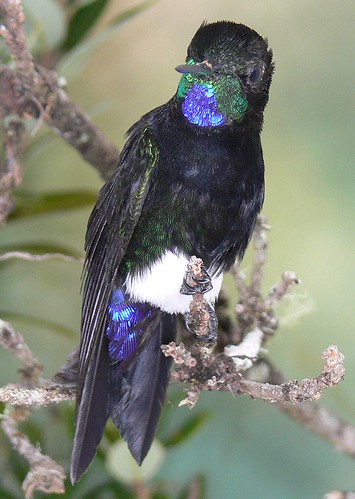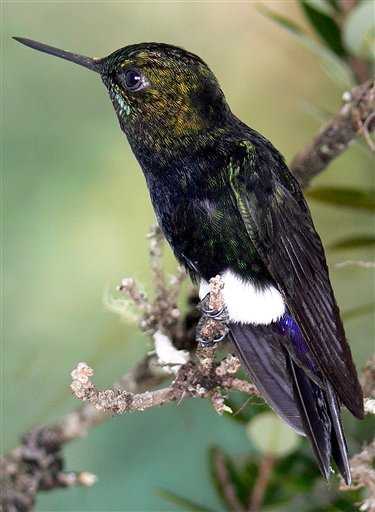tags: hummingbird, Gorgeted Puffleg, Eriocnemis Isabellaea, endangered species, ornithology, birds
A new species of hummingbird, the Gorgeted Puffleg, Eriocnemis Isabellaea, has been discovered in the Serrania del Pinche mountains of southwest Colombia.
According to ornithologists, the Gorgeted Puffleg has been discovered living in the cloud forests of southwestern Colombia. Despite its recent discovery, this stunning rare hummingbird that has violet blue plumage and iridescent green on its throat, is already endangered by the environmentally damaging illegal drugs industry.
"We were essentially following a hunch," said Alexander Cortés-Diago of the Hummingbird Conservancy in Colombia and co-discoverer of Gorgeted Puffleg. "We had heard that a new species of plant had been discovered in the region in 1994. This discovery and the isolation of the Serrania led us to believe there could also be new species of vertebrates."
According to its discoverers, the new species measures between 3.5 inches and four inches in length. The bird gets its unusual name from its enlarged, bicoloured iridescent throat patch (its "gorget") and from the appearance of having "little cotton balls above their legs," said Luis Mazariegos-Hurtado, who has spent 30 years documenting hummingbirds and founded the Colombian Hummingbird Conservancy.
The new species, which was recently given the scientific name, Eriocnemis isabellae, was confirmed by two of the world's leading specialists on the puffleg, Karl L. Schuchmann, curator of ornithology at Zoological Research Museum A. Koenig in Germany, and F. Gary Stiles of the Natural Sciences Institute at the National University of Colombia.
"The description of the species has been published in Ornitologica Neotropical, a well respected peer-reviewed journal," said Greg Butcher, director of bird conservation for the Washington-based National Audubon Society. "The description of the bird in that journal leaves no doubt that it is a very distinctive species, and will be accepted as such by the ornithological community."
The two field ornithologists who discovered the hummingbird saw it three times in 2005 while they conducted field surveys of the mountain cloud forest in the Serrania del Pinche mountains in southwest Colombia. In 2006, they returned to confirm the sighting despite the presence of leftist rebels and drug traffickers in the region. They photographed the birds in 2006, and sent the images to the Zoological Research Museum A. Koenig in Germany for confirmation.
"We immediately suspected the bird as a new species," said Andre Weller of the Brehm Fund for International Bird Conservation/Zoological Research Museum A. Koenig. "Further study has shown that this is certainly the most spectacular discovery of a new hummingbird taxon during the last decade or more."
The mountainous Serrania del Pinche region may hold other new species but their future isn't secure because of slash-and-burn farming by coca farmers in the region. This destructive method of farming, combined with the bird's small range give ornithologists cause for concern that this bird may slip into extinction. Coca is the raw material in cocaine.
"Destruction of habitat is the main threat caused by the migration of coca fields from the Caqueta and Putumayo areas to the Pacific," said Luis Mazariegos-Hurtado of the Hummingbird Conservancy in Colombia. He added that slash-and-burn agriculture is expanding in the area, and this farming technique can cause "dangerous fires that can easily burn a whole mountain."
Researchers are especially worried because the hummingbird has only been sighted on one mountain ridge. Ornithologists are asking the Colombian government to protect this area.
"To go undiscovered for so long, the bird's range must be extremely small and fragile -- hence conservation action is undoubtedly a priority for the Serrania del Pinche," said Ian Davidson of the conservation group Birdlife International.
The Gorgeted Puffleg brings to 15 the number of species in this genus, which are mostly found in Colombia. There are more than 300 species of hummingbirds in the world, nearly half of which live in Colombia. Further, Colombia is a gold mine for bird species, with more than 1,800 total native species.
"This is a discovery with mixed emotions: the indescribable happiness of finding a new hummingbird and the harsh reality that this may be one of the most endangered species outside of an unprotected area." said Luis Alfonso Ortega, co-discoverer of the hummingbird.
This undated photo release by BirdLife International on Sunday, May 13, 2007, shows the new species of hummingbird, called the Gorgeted Puffleg, Eriocnemis Isabellaea, discovered in the Serrania del Pinche mountains, southwest Colombia. The highly distinct new species is characterized by an enlarged, iridescent throat patch in males and white tufts above the legs.
Sources
BirdLife International (quotes, images).
MSNBC news (quotes).
Edmonton Journal (quotes).



Just beautiful! Especially the "back-up lights". Very cool...
Wouldn't it be nice to put the drug catels and their farmer-enablers out of business by legalizing a number of recreational drugs? I wonder if use would go down without the cachet of illegality. Some people will abuse recreational substances whether legal or not (check out drunk-driving deaths), but the religious wingnuts will not even allow cancer patients to treat pain with Cannabis. Meanwhile poppy fields in Southeast Asia and coca fields in South America are chugging right along despite Dubya's posturing re the War on Drugs. Go figure. Oh, and before we forget, praise the Lord that daughters of the Religious Right will get cervical cancer as a punishment for sex with an infected person: serves 'em right, and banish the HPV vaccine. Jerry Falwell had it down. Wonder how he is explaining things to the nonexistent god in the sky.
Thank you for sharing this truly beautiful and amazing discovery. Do you know how many birds of this variety are known to exist, and what are the chances that these birds would leave their habitat and migrate to the U.S? Is there anything that hummingbird lovers can do to ensure that this newly discovered species will be able to survive and that more of these gorgeous birds will be born? This bird is so beautiful that it would be criminal for bird lovers to stand by and allow anything to cause its extinction before it is even well known.
How do average people go about ensuring the protection of a natural habitat such as the one where these birds live -- even if that habitat lies within an area that is also known to be the habitat for coca, which I assume is grown for cocaine production?
There is no chance that this bird would ever make it to the United States naturally. Like other species of the Eriocnemis genus, it is presumably restricted to high elevations in the Andes of South America (>2000 metres). The leg 'puffs' are thought by some to help keep the bare legs of the hummingbird from losing heat in the often inclement weather of the high Andes.
To support bird conservation in Colombia, you can support ProAves Colombia (www.proaves.org) where it is simple to make an online donation. This organization is already actively involved in the conservation of the Gorgeted Puffleg's arguably more beautiful close relative, the Colorful Puffleg, a critically-endangered species.
That's incredible. I hope we can find a way to help that spectacular bird survive and thrive.